What You Need to Know About Processed Food
Processed food fills grocery store aisles and dominates most American diets, but many people don’t realize what they’re actually eating or how it affects their health. This guide is for anyone who wants to make better food choices for themselves and their families without getting overwhelmed by confusing nutrition information.
You’ll discover what processed food really means beyond the obvious frozen dinners and chips. We’ll also explore the hidden health risks that food companies don’t advertise and share practical strategies for reading food labels like a pro. Finally, you’ll learn how to cut back on processed foods without spending a fortune or completely overhauling your lifestyle.
Making smarter food choices doesn’t have to be complicated or expensive when you know what to look for.
Understanding What Processed Food Really Means
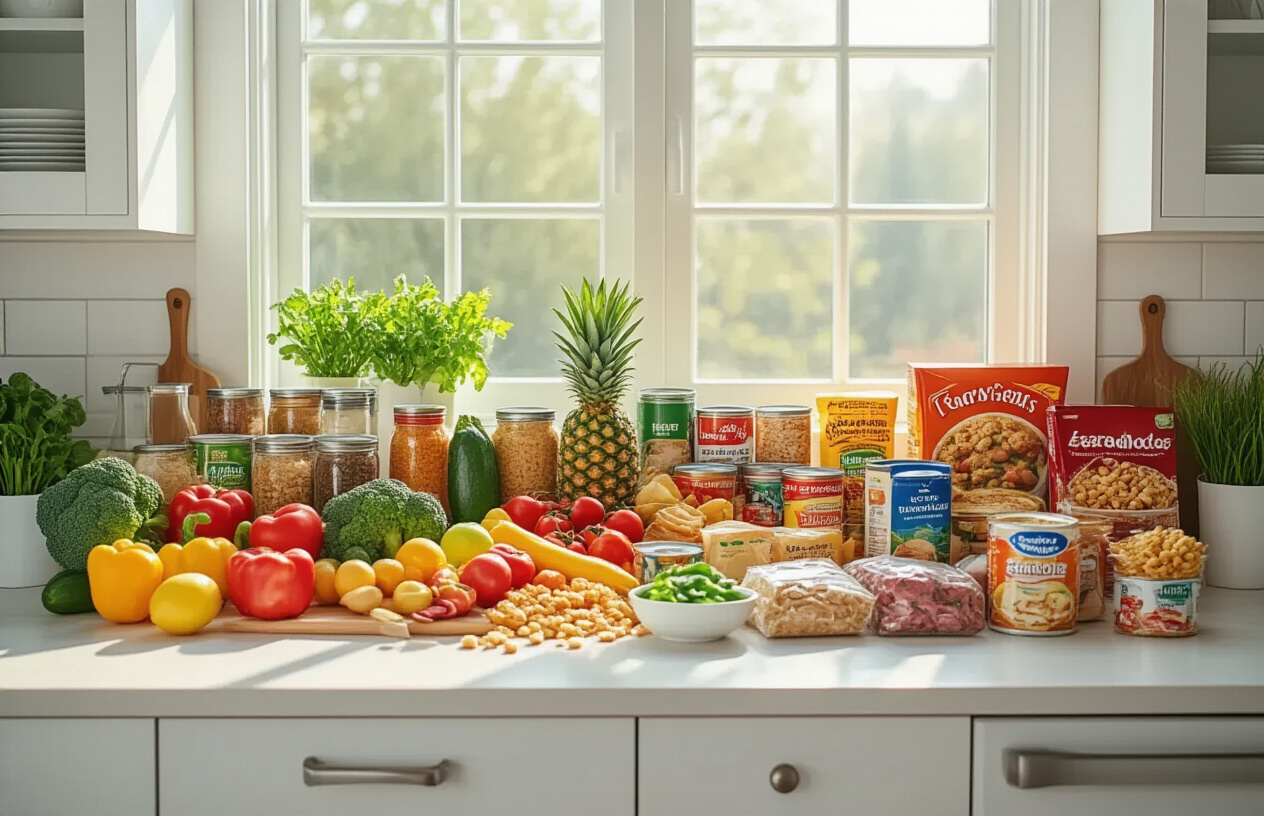
Defining the different levels of food processing
Food processing exists on a spectrum that ranges from barely touched to heavily manufactured. The NOVA classification system breaks this down into four clear categories that help us understand what we’re actually eating.
Group 1: Unprocessed or minimally processed foods include fresh fruits, vegetables, nuts, seeds, meat, fish, and milk. These foods might be cleaned, portioned, or frozen, but their basic structure remains intact.
Group 2: Processed culinary ingredients are substances extracted from Group 1 foods or nature, like oils, butter, sugar, salt, and vinegar. You typically use these to prepare and season Group 1 foods rather than eat them alone.
Group 3: Processed foods combine Group 1 and Group 2 ingredients using traditional preservation methods. Think canned vegetables, cheese, freshly baked bread, or cured meats. These foods usually contain 2-3 ingredients and remain recognizable as modified versions of their original form.
Group 4: Ultra-processed foods represent the most heavily modified category. These products undergo multiple industrial processes and contain ingredients you wouldn’t find in a typical home kitchen—things like high-fructose corn syrup, modified starches, protein isolates, and various additives for color, flavor, and preservation.
Distinguishing between minimally and ultra-processed foods
The gap between minimally processed and ultra-processed foods is vast, and recognizing this difference can dramatically impact your health decisions.
Minimally processed foods maintain their natural nutritional profile. When you buy frozen berries, pre-cut vegetables, or plain yogurt, you’re getting essentially the same nutrients as the fresh version. The processing serves practical purposes—extending shelf life, improving safety, or adding convenience—without fundamentally altering the food’s composition.
Ultra-processed foods tell a different story. These products are engineered for maximum palatability, shelf stability, and profit margins. They’re designed to hit specific taste, texture, and convenience targets that keep you coming back. The original ingredients become so transformed that the end product bears little resemblance to anything found in nature.
Here’s a simple test: if you can’t recreate the food in your own kitchen with reasonable effort and common ingredients, it’s likely ultra-processed. You could make your own tomato sauce, but recreating the exact formulation of a packaged snack food would be nearly impossible without industrial equipment and specialized additives.
The ingredient list tells the story too. Ultra-processed foods typically contain more than five ingredients, many with names you can’t pronounce or wouldn’t recognize as food.
Common examples found in your daily diet
Ultra-processed foods have become so normalized that many people don’t realize how much of their diet consists of these products.
Breakfast might start with flavored instant oatmeal (ultra-processed) instead of plain oats (minimally processed), sweetened yogurt with artificial flavors rather than plain yogurt with fresh fruit, or pastries and breakfast bars loaded with preservatives and stabilizers.
Lunch and dinner often feature frozen meals, pizza, chicken nuggets, flavored rice mixes, instant soups, and processed meats like hot dogs or deli slices pumped with nitrates and fillers. Even seemingly healthy options like veggie burgers or protein bars frequently fall into the ultra-processed category.
Snacks and beverages represent the biggest ultra-processed culprits: chips, crackers, cookies, candy, soda, energy drinks, flavored coffee beverages, and fruit drinks that contain little actual fruit.
Condiments and sauces often bridge the gap between processed and ultra-processed. Basic ketchup might have tomatoes, vinegar, and sugar, while ultra-processed versions include high-fructose corn syrup, modified food starch, and multiple preservatives.
The key insight? Ultra-processed foods now make up about 60% of the average American’s caloric intake. These aren’t occasional treats—they’ve become dietary staples, which explains why understanding food processing levels matters so much for your long-term health.
Hidden Health Risks You Should Be Aware Of
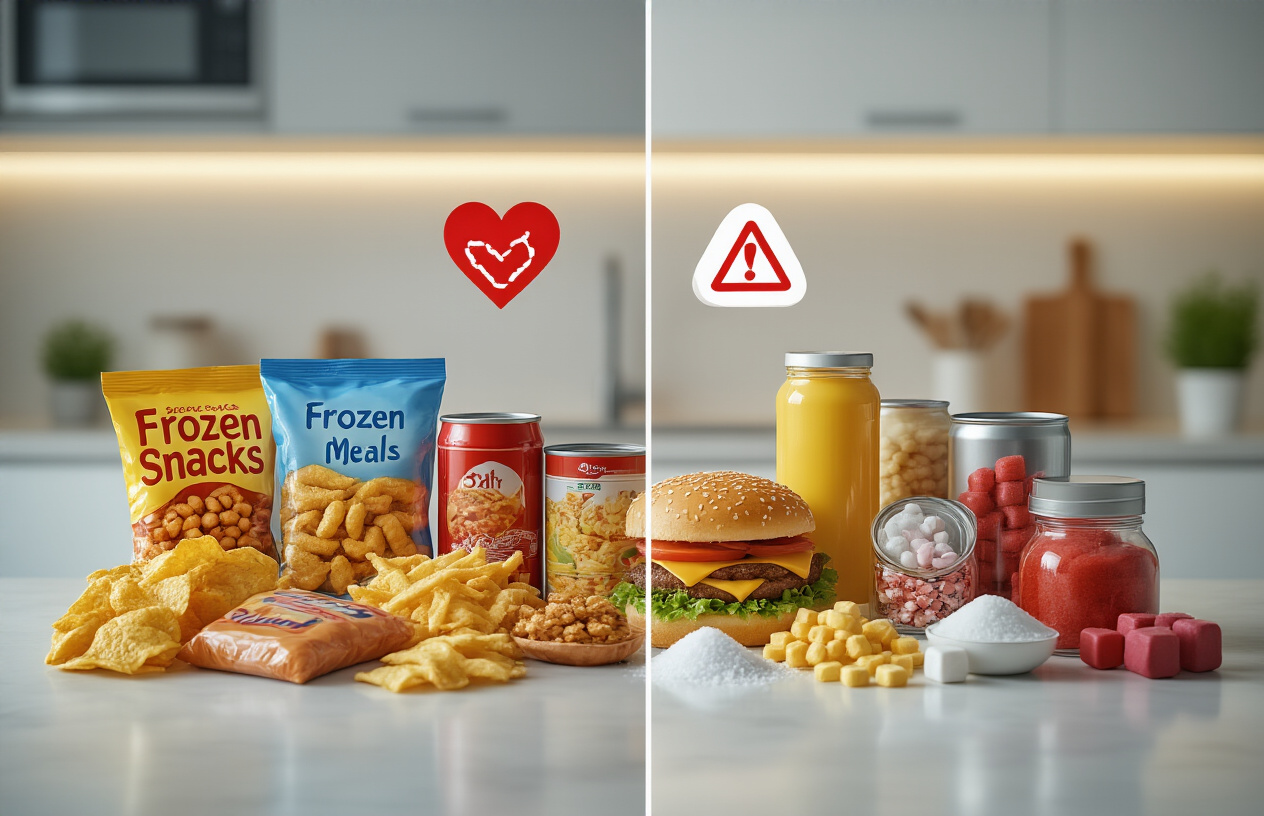
How excess sodium impacts your cardiovascular system
Processed foods pack a serious sodium punch that your heart definitely feels. Most Americans consume nearly double the recommended daily limit of 2,300mg, with processed foods contributing about 70% of that intake. Your body only needs around 500mg of sodium daily to function properly, yet that single frozen dinner or can of soup often contains your entire day’s worth.
When you regularly eat high-sodium processed foods, your blood vessels start working overtime. Sodium makes your body hold onto extra water, which increases blood volume and forces your heart to pump harder. This extra pressure damages artery walls over time, creating the perfect storm for high blood pressure, heart disease, and stroke.
The sneaky part? Many processed foods don’t even taste particularly salty. Bread, cereal, and deli meats are major sodium contributors that fly under your taste radar. Your palate adapts to these elevated levels, making naturally seasoned foods taste bland by comparison.
The truth about added sugars and weight gain
Added sugars in processed foods create a metabolic mess that goes way beyond simple calorie counting. Unlike natural sugars found in fruits, processed sugars hit your bloodstream fast and hard, triggering insulin spikes that promote fat storage, particularly around your midsection.
High fructose corn syrup, commonly used in processed foods, bypasses your body’s natural satiety signals. Your brain doesn’t register these liquid calories the same way it does solid food, so you keep eating without feeling full. This leads to overconsumption and steady weight gain over time.
The average American consumes about 17 teaspoons of added sugar daily, with processed foods being the primary culprit. Soft drinks, flavored yogurts, breakfast cereals, and even seemingly healthy granola bars contain shocking amounts of hidden sugars.
| Common Processed Food | Added Sugar Content |
|---|---|
| Regular soda (12 oz) | 10 teaspoons |
| Flavored yogurt (6 oz) | 4-6 teaspoons |
| Granola bar | 2-4 teaspoons |
| Breakfast cereal (1 cup) | 3-4 teaspoons |
Why preservatives may disrupt your gut health
Your gut microbiome houses trillions of beneficial bacteria that keep your digestive system running smoothly. Many preservatives commonly found in processed foods act like tiny antibiotics, wiping out both harmful and helpful bacteria indiscriminately.
Artificial preservatives like sodium benzoate and potassium sorbate can alter your gut’s bacterial balance, potentially leading to digestive issues, weakened immunity, and even mood changes. Your gut produces about 90% of your body’s serotonin, so when preservatives throw off this delicate ecosystem, you might notice changes in your mental well-being too.
Emulsifiers, used to keep processed foods smooth and consistent, can thin your protective gut lining. This makes your intestinal barrier more permeable, potentially allowing harmful substances to enter your bloodstream and trigger inflammatory responses throughout your body.
Understanding the link between processing and nutrient loss
The more a food gets processed, the more nutrients it loses along the way. Heat treatment, chemical processing, and extended storage times strip away vitamins, minerals, and beneficial compounds that your body needs to thrive.
Take whole grains versus refined flour as an example. Processing removes the nutrient-dense bran and germ, leaving behind mostly empty carbohydrates. While manufacturers sometimes add synthetic vitamins back in, these don’t provide the same benefits as naturally occurring nutrients.
Processing also destroys delicate antioxidants and phytonutrients that help protect your cells from damage. Fresh fruits and vegetables contain thousands of these protective compounds, but canned and packaged versions lose significant amounts during processing and storage.
The bioavailability of nutrients changes too. Natural folate from leafy greens gets absorbed differently than synthetic folic acid added to processed cereals. Your body recognizes and uses whole food nutrients more efficiently than their manufactured counterparts.
Smart Strategies for Reading Food Labels
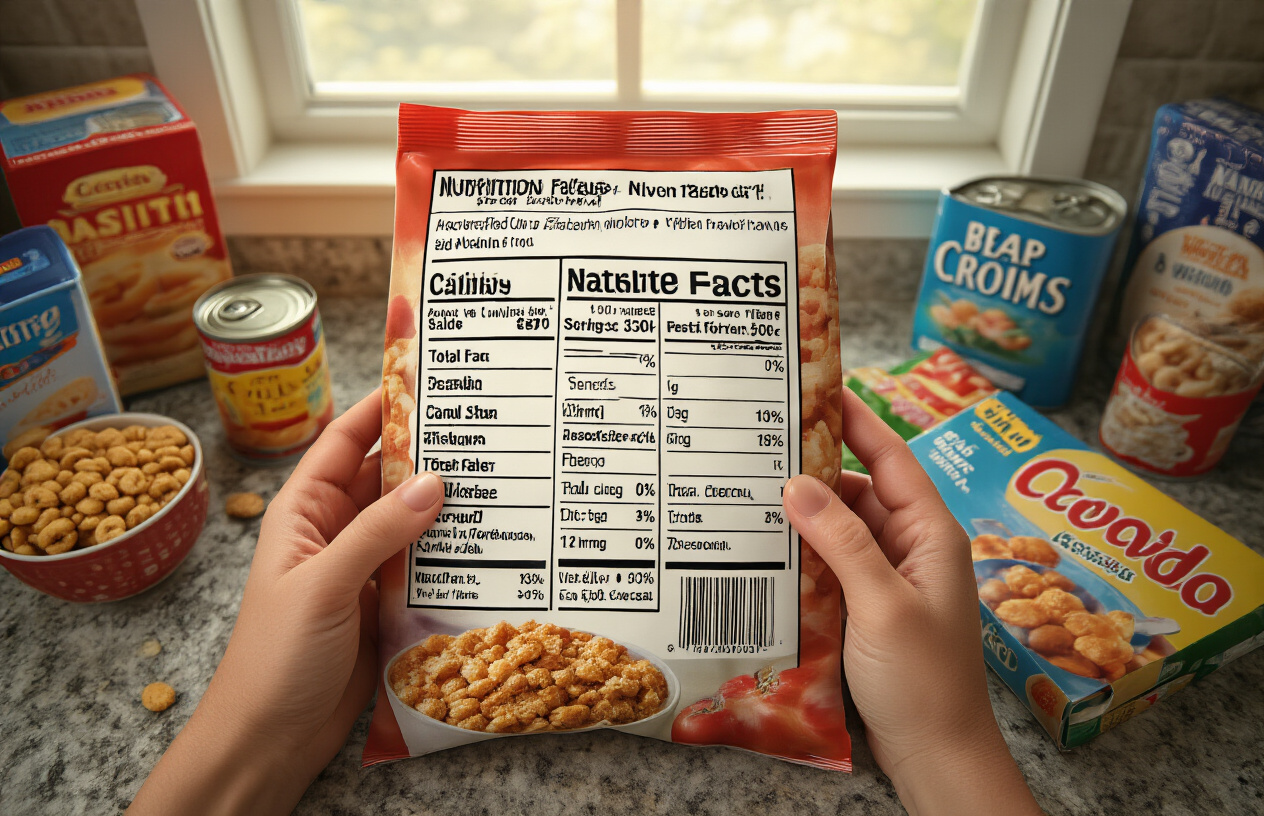
Decoding ingredient lists like a nutrition expert
Ingredients appear in descending order by weight, so the first five items make up most of what you’re eating. When sugar shows up multiple times under different names like high fructose corn syrup, dextrose, and maltodextrin, that’s your cue to walk away. These sneaky manufacturers split sugar into various forms to push it further down the list.
Look for ingredient lists you can actually pronounce. Real food doesn’t need a chemistry degree to understand. If your grandmother wouldn’t recognize half the ingredients, your body probably won’t either. Short lists typically mean less processing, while lengthy ingredient panels often signal heavy manipulation.
Watch out for vague terms like “natural flavors” or “spices” – these catch-all phrases can hide dozens of unnamed additives. The word “natural” doesn’t mean healthy; it just describes the original source before extensive processing transformed it into something unrecognizable.
Identifying red flag additives to avoid
Certain preservatives and additives raise serious health concerns. Sodium nitrates and nitrites, commonly found in processed meats, have links to cancer formation. BHA and BHT preservatives may disrupt hormone function and have been banned in several countries.
Artificial colors, especially Red 40, Yellow 5, and Yellow 6, can trigger hyperactivity in children and allergic reactions in sensitive individuals. These synthetic dyes serve no nutritional purpose and often appear in the most processed foods.
| Additive Type | Common Names | Health Concerns |
|---|---|---|
| Preservatives | Sodium benzoate, Potassium sorbate | Allergic reactions, DNA damage |
| Emulsifiers | Polysorbate 80, Carrageenan | Gut inflammation, digestive issues |
| Sweeteners | Aspartame, Sucralose | Headaches, mood changes |
| Flavor enhancers | MSG, Disodium guanylate | Headaches, nausea |
Trans fats hide under names like “partially hydrogenated oils” and should be avoided completely. Even small amounts increase heart disease risk and inflammation throughout your body.
Understanding misleading marketing terms
Food companies excel at making processed products sound healthy through clever marketing speak. “Made with real fruit” might mean a tiny amount of fruit juice concentrate mixed with artificial flavors and colors. “Multigrain” sounds nutritious but often just means multiple refined grains with no whole grain benefits.
“All natural” has no legal definition and appears on everything from candy to chips. This term tells you nothing about nutritional value or processing methods. Similarly, “organic” processed food is still processed food – organic cookies remain cookies.
Terms like “reduced fat” or “low sodium” compare the product to the original version, not to healthy alternatives. These products often compensate for removed ingredients by adding extra sugar, salt, or artificial additives to maintain taste.
“No added sugar” doesn’t mean sugar-free. Companies use concentrated fruit juices, which are essentially sugar, to sweeten products while technically avoiding added refined sugar. Check the total sugar content instead of falling for these word games.
“Fortified” or “enriched” indicates that synthetic vitamins were added back after processing stripped away natural nutrients. Whole foods provide these vitamins naturally without the need for artificial supplementation.
Making Healthier Choices Without Breaking Your Budget

Finding whole food alternatives that save money
Buying whole foods doesn’t have to drain your wallet. Start with staples like dried beans, lentils, and whole grains – these cost pennies per serving compared to their processed counterparts. A bag of dried black beans costs around $2 and makes the equivalent of six cans, saving you at least $4 per bag.
Rice, oats, and quinoa bought in bulk can slash your grocery bill by 30-50%. Many stores offer bulk bins where you can scoop exactly what you need. Seasonal produce is your best friend for fresh options at rock-bottom prices. Stock up when items are in season and freeze extras for later use.
Eggs are nutritional powerhouses that cost less than $3 per dozen in most areas. They’re incredibly versatile and can replace expensive protein sources in many meals. Frozen vegetables often cost less than fresh and retain their nutritional value, making them perfect budget-friendly whole food swaps.
Budget-friendly meal prep techniques for busy schedules
Batch cooking transforms both your health and your bank account. Dedicate 2-3 hours on Sunday to prepare proteins, grains, and chopped vegetables for the week. Cook large portions of versatile bases like brown rice, roasted chicken, and steamed vegetables that can be mixed and matched throughout the week.
One-pot meals save time, money, and cleanup. Soups, stews, and casseroles use affordable ingredients and create multiple servings. A big batch of chili or vegetable soup costs under $10 and provides 6-8 meals.
Prep snacks in advance to avoid vending machine temptations. Cut vegetables, portion nuts, and prepare homemade trail mix on prep day. This prevents impulse purchases of expensive processed snacks and keeps you satisfied between meals.
Smart shopping tips for healthier processed options
When you do buy processed foods, read ingredient lists carefully. Choose products with five ingredients or fewer, and make sure you can pronounce everything on the list. Compare unit prices rather than package prices to find the best deals.
Generic brands often offer cleaner ingredient profiles at lower costs than name brands. Store brands for items like canned tomatoes, frozen vegetables, and whole grain pasta typically contain the same quality ingredients without premium pricing.
Shop the perimeter of the store first, where whole foods are typically located. Fill most of your cart before venturing into processed food aisles. This strategy naturally limits processed food purchases while ensuring you get nutrient-dense options first.
Simple swaps that dramatically improve your diet quality
Replace sugary breakfast cereals with overnight oats topped with fresh fruit. This swap eliminates artificial flavors and excess sugar while costing 60% less per serving. Mix oats with milk, yogurt, and fruit the night before for grab-and-go convenience.
Swap flavored yogurts for plain Greek yogurt with your own fruit additions. Flavored varieties contain 15-20 grams of added sugar, while plain yogurt with fresh berries gives you more protein and natural sweetness for less money.
Choose whole grain bread over white bread, but check labels for added sugars and preservatives. Many “wheat” breads are just white bread with coloring. Look for “100% whole grain” as the first ingredient.
Replace processed snack bars with homemade versions using oats, nuts, and dried fruit. Five minutes of mixing creates a week’s worth of snacks for half the cost of store-bought bars. These swaps add up to significant health improvements and budget savings over time.
Practical Steps to Reduce Your Processed Food Intake
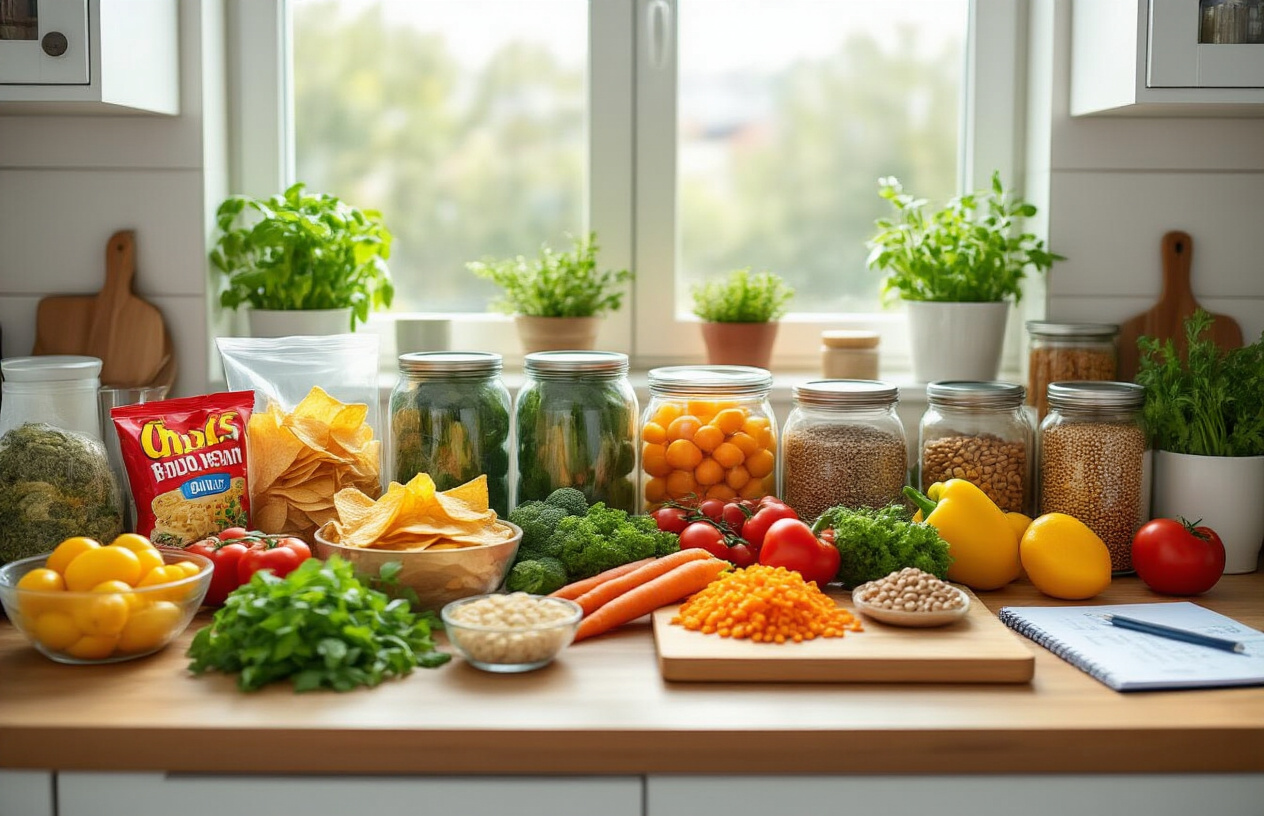
Creating a sustainable transition plan that works
Start small rather than overhauling your entire diet overnight. Pick one meal per day to focus on first – breakfast works well since it’s usually the simplest. Swap that sugary cereal for overnight oats with fresh fruit, or replace frozen waffles with whole grain toast topped with avocado.
Set realistic weekly goals that build momentum. Week one might be eliminating sugary drinks, week two could focus on replacing packaged snacks, and week three might tackle lunch preparation. Track your progress with a simple checklist or phone app to stay motivated.
Stock your kitchen strategically by removing the most tempting processed items from easy reach. Fill your pantry with whole food staples like quinoa, brown rice, canned beans, nuts, and frozen vegetables. When healthy options are the most convenient choice, you’ll naturally reach for them.
Plan your meals three days ahead to avoid last-minute processed food purchases. Keep a running grocery list on your phone and shop the perimeter of the store first, where fresh produce, dairy, and proteins live. The middle aisles contain most processed foods, so limit your time there.
Building cooking skills for quick homemade meals
Master five basic cooking methods that work for multiple ingredients: roasting, sautéing, steaming, grilling, and one-pot cooking. Once you’re comfortable with these techniques, you can create countless meal combinations using different proteins, vegetables, and seasonings.
Batch cooking becomes your best friend for busy weekdays. Dedicate Sunday afternoons to preparing large quantities of versatile ingredients like roasted vegetables, cooked grains, and proteins that can be mixed and matched throughout the week. A sheet pan of roasted chicken thighs and vegetables takes minimal effort but provides several meals.
Keep your spice collection diverse to prevent boredom. Basic seasonings like garlic powder, cumin, paprika, Italian herbs, and soy sauce can transform simple ingredients into flavorful meals. Experiment with different spice combinations to discover your favorites.
| Cooking Method | Time Required | Best For |
|---|---|---|
| Sheet Pan Roasting | 25-30 mins | Vegetables, proteins |
| Stir-frying | 10-15 mins | Quick dinners |
| One-pot meals | 20-30 mins | Easy cleanup |
| Slow cooking | 4-8 hours | Hands-off cooking |
Preparing healthy snacks to replace packaged options
Fresh fruit paired with nuts or nut butter satisfies sweet cravings while providing sustained energy. Apple slices with almond butter, berries with Greek yogurt, or banana with a handful of walnuts beat any processed granola bar.
Vegetable-based snacks offer satisfying crunch without empty calories. Cut up bell peppers, carrots, and cucumbers on Sunday and store them in clear containers for easy grabbing. Pair with hummus, guacamole, or plain Greek yogurt mixed with herbs for extra flavor.
Make your own trail mix using raw nuts, seeds, and a small amount of dried fruit without added sugar. This costs less than pre-packaged versions and lets you control the ingredients and portions.
Hard-boiled eggs prepared in advance provide portable protein that keeps you full between meals. Season them with everything bagel seasoning, hot sauce, or a sprinkle of salt and pepper for variety.
Energy balls made from dates, nuts, and seeds require no baking and store well in the refrigerator. Blend pitted dates with your favorite nuts and roll into bite-sized portions for a naturally sweet treat that beats any processed energy bar.
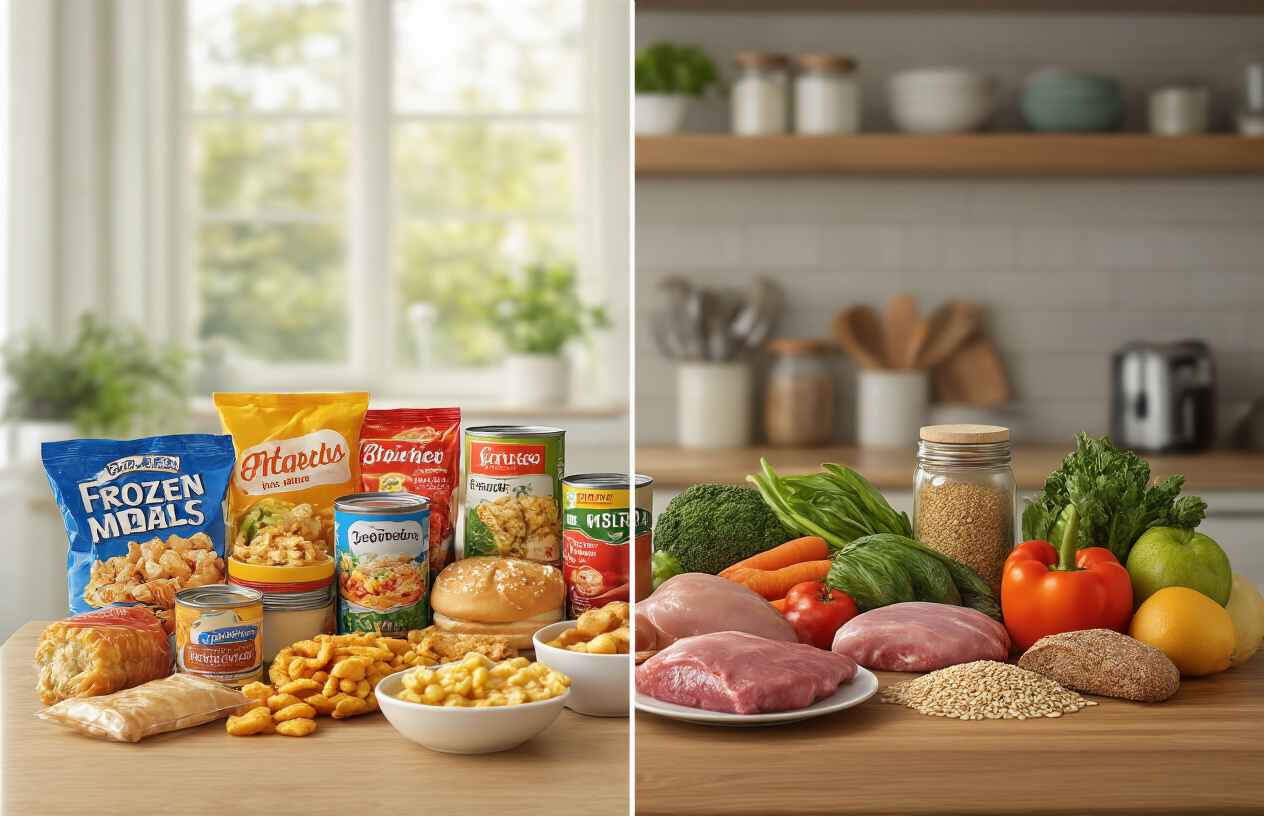
Processed foods have become a regular part of our daily meals, but knowing what they really are and how they affect our health can help you make better choices for yourself and your family. From understanding those tricky food labels to spotting hidden health risks, the key is being informed about what you’re putting in your cart and on your plate.
The good news is that eating healthier doesn’t have to empty your wallet or completely change your lifestyle overnight. Start small by swapping one or two processed items for whole food alternatives each week, and gradually build healthier habits that stick. Your body will thank you for choosing fresh ingredients over heavily processed options, and you’ll likely notice improvements in how you feel and your overall energy levels.














